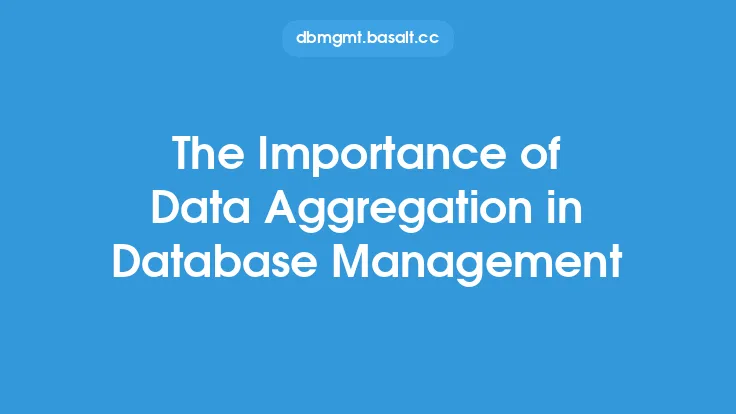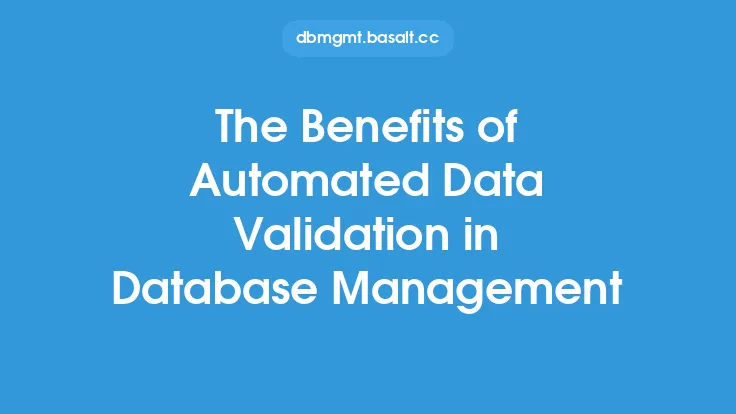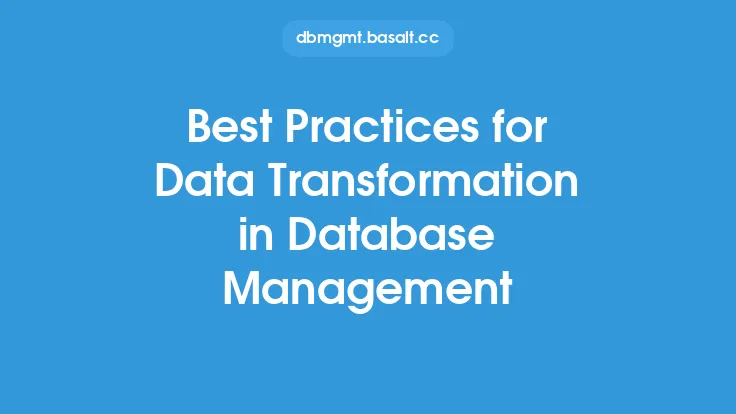The field of data integration has undergone significant transformations in recent years, driven by the increasing complexity of data sources, the rise of big data, and the need for real-time insights. As organizations strive to make data-driven decisions, the importance of effective data integration has become more pronounced. In this context, it is essential to explore the trends and future directions in data integration for database management, highlighting the key developments, challenges, and opportunities that shape this critical aspect of database implementation.
Introduction to Data Integration Trends
Data integration trends are influenced by various factors, including the proliferation of cloud-based services, the growth of the Internet of Things (IoT), and the increasing adoption of artificial intelligence (AI) and machine learning (ML) technologies. One of the primary trends in data integration is the shift towards cloud-based data integration platforms, which offer greater scalability, flexibility, and cost-effectiveness compared to traditional on-premises solutions. Additionally, the rise of serverless computing and containerization has enabled organizations to deploy data integration workloads more efficiently, reducing the administrative burden and improving overall system performance.
Evolution of Data Integration Architectures
The evolution of data integration architectures is another significant trend in this space. Traditional data integration architectures, such as ETL (Extract, Transform, Load) and ELT (Extract, Load, Transform), are being replaced by more modern approaches, including data virtualization, data lakes, and data warehouses. Data virtualization, for instance, enables organizations to access and integrate data from multiple sources in real-time, without the need for physical data movement. Data lakes, on the other hand, provide a centralized repository for storing raw, unprocessed data, which can be processed and analyzed using various tools and technologies. The choice of data integration architecture depends on the specific use case, data volume, and performance requirements, and organizations are increasingly adopting hybrid approaches that combine the benefits of multiple architectures.
Role of Artificial Intelligence and Machine Learning
Artificial intelligence (AI) and machine learning (ML) are playing an increasingly important role in data integration, enabling organizations to automate data integration processes, improve data quality, and enhance decision-making. AI-powered data integration tools can automatically detect data patterns, identify data relationships, and recommend data transformations, reducing the need for manual intervention and improving overall efficiency. ML algorithms can be used to predict data integration errors, detect data anomalies, and optimize data integration workflows, ensuring that data is accurate, complete, and consistent across the organization. Furthermore, AI and ML can help organizations to identify new data sources, integrate data from disparate systems, and provide real-time insights, enabling them to respond quickly to changing business conditions.
Impact of Big Data and IoT on Data Integration
The proliferation of big data and IoT devices has significant implications for data integration, as organizations need to handle large volumes of structured and unstructured data from diverse sources. Big data integration requires specialized tools and technologies, such as Hadoop, Spark, and NoSQL databases, which can handle large-scale data processing and analytics. IoT data integration, on the other hand, requires real-time data processing and analytics, as well as the ability to handle streaming data from devices and sensors. The integration of big data and IoT data with traditional data sources poses significant challenges, including data quality, data security, and data governance, and organizations need to develop strategies to address these challenges and unlock the full potential of their data assets.
Data Integration and Cloud Computing
Cloud computing has revolutionized the field of data integration, providing organizations with scalable, on-demand infrastructure and platforms for integrating and analyzing data. Cloud-based data integration platforms, such as AWS Glue, Google Cloud Data Fusion, and Azure Data Factory, offer a range of benefits, including reduced costs, increased agility, and improved collaboration. Cloud computing also enables organizations to adopt a pay-as-you-go model, reducing the upfront costs associated with data integration and improving overall ROI. Furthermore, cloud-based data integration platforms provide built-in support for AI and ML, enabling organizations to automate data integration processes and improve data quality, as well as integrate data from diverse sources, including on-premises systems, cloud-based applications, and IoT devices.
Future Directions in Data Integration
The future of data integration is likely to be shaped by several factors, including the increasing adoption of cloud-based services, the growth of AI and ML, and the proliferation of big data and IoT devices. One of the key future directions in data integration is the development of autonomous data integration systems, which can automatically detect data sources, integrate data, and optimize data integration workflows. Another future direction is the integration of data integration with other disciplines, such as data governance, data quality, and data security, to provide a more comprehensive and integrated approach to data management. Additionally, the increasing use of containerization, serverless computing, and edge computing will enable organizations to deploy data integration workloads more efficiently, reducing latency and improving overall system performance.
Challenges and Opportunities in Data Integration
Despite the many advances in data integration, several challenges and opportunities remain. One of the primary challenges is the increasing complexity of data sources, which requires organizations to develop more sophisticated data integration strategies. Another challenge is the need for real-time data integration, which requires organizations to adopt more agile and responsive data integration architectures. The increasing use of AI and ML also poses challenges, such as the need for high-quality training data and the risk of bias in ML models. However, these challenges also present opportunities, such as the ability to automate data integration processes, improve data quality, and provide real-time insights, enabling organizations to make better decisions and drive business success.
Conclusion
In conclusion, the field of data integration is undergoing significant transformations, driven by the increasing complexity of data sources, the rise of big data, and the need for real-time insights. As organizations strive to make data-driven decisions, the importance of effective data integration has become more pronounced. The trends and future directions in data integration, including the shift towards cloud-based data integration platforms, the evolution of data integration architectures, and the increasing use of AI and ML, will shape the future of data management and analytics. By understanding these trends and future directions, organizations can develop more effective data integration strategies, unlock the full potential of their data assets, and drive business success in a rapidly changing world.





